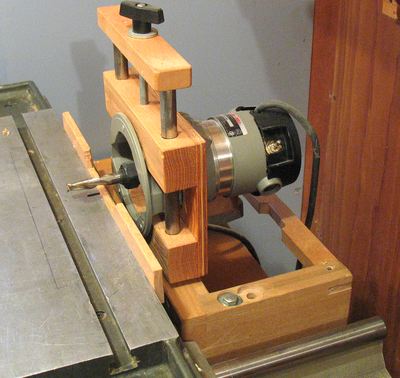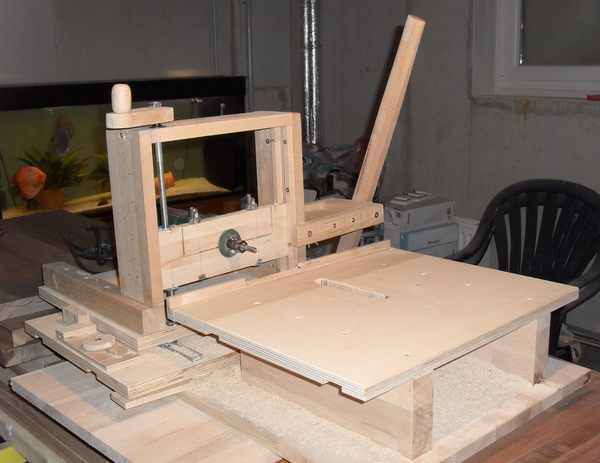Diy Slot Mortiser
Overall dimensions: 18'w × 53 ⁄4'd × 10'h
More videos about the slot mortiser: Using the slot mortiser for some shelves Steve Emmons video about his machine Tony C's slide show / video about his mortising machine My earlier video about the machine (from 2009) More on Mortise and tenon joinery. Back to my Woodworking website. The STS Slot Mortiser solves this by providing positioning scales for both the mortise length stop blocks, and for the distance of the integrated fence from that bit. Setting the width and depth of cut takes only a few seconds, and you can return to a position for repeat cuts reliably and just as fast.
Some woodworkers discount loose tenons as the poor machine-cut cousin of traditional mortise-and-tenon joinery, but I’ve found the joint useful in many instances. Joining parts using a pair of matching mortises and a snug-fitting wood strip, instead of the sawing a tenon to fit a mortise, saves stock. And with the proper setup, loose tenon joinery is just as strong as its competition, but quicker and easier to accomplish.
- Homemade slot mortiser w/ PICS.LINK. Re: Costs of 80/20 Re: Costs of 80/20 Re:Shaft material Thanks.NM. Re: Homemade slot mortiser w/ PICS Re: Thoughts. Well done Paul Re: Well done Paul BRAVO! Great dust collection. Re: Homemade slot mortiser w/ PICS Re: Homemade slot mortiser w/ PICS Nice setup Paul Awesome!
- Consider supporting me on: This little machine will be used for cutting slotted notches on my custom door pieces.
- Mar 14, 2015 - www.
Wanting a slot mortiser but not willing to spend money for a commercial model, I used leftover material and spare hardware to create a simple rail-guided mortising jig for my plunge router. Despite my initial success, I further improved the jig by adding Bessey’s auto-adjust toggle clamps. Now my revised jig is just as reliable and accurate as its predecessor, but thanks to the new toggles, slippage is a thing of the past. Once set, the auto-adjust hold-downs provide the same amount of pressure on a 21⁄2'- thick leg as on a 3⁄4' rail without needing to adjust the footpad.
The jig can hold stock up to 8' wide and 33⁄4' thick. By adjusting the base dimensions, you can easily mortise still larger parts.
Build the base
1 As shown in Figure 1, make the base in sections, starting with the body. From 3⁄4'-thick MDF, cut three pieces slightly larger than the finished dimensions. Laminate the pieces together, and then trim an edge and end to correct an uneven edge and slice away any squeeze-out. Now trim the uncut edge and end to final dimensions. Cut two 1⁄2'- deep dadoes across the front face, where shown, to fit the T-track.
2 From 3⁄4'-thick MDF, cut the stop support and inner track. Glue the stop support to the body, where shown. Use a piece of T-track to ensure that the installed track will be flush with the jig’s top edge. Let the glue cure, and then attach the inner track, again using T-track to ensure that the jig’s top edge is flush.
3 From 1⁄2'-thick MDF, cut the filler and outer track to size. Glue the two together, and then attach them to the inner track with glue and 2' screws. Wipe away any squeeze-out, especially in the groove for the guide rail.
4 To make the bottom section, start with two oversized pieces of 3⁄4'-thick MDF, glue and clamp the stack together, and then trim to final dimension. Drill clearance holes where shown, and then attach with glue and 3'-long screws. Make sure that the front edge of the bottom is flush with the jig’s face.
5 Using a hacksaw, cut the T-track into three 14'-long sections, and attach them to the assembled base where shown, with 1⁄2'-long screws.
6 Cut the stops from 3⁄4' plywood, drill holes, and attach to the top T-track, as shown.
7 Plane a strip of hardwood to fit within the outer and inner tracks to serve as the rail for your router’s edge guide. Finally, draw a centerline across the top and front face of the jig.
Build the end fence and hold-downs
1 Laminate 1⁄2'-thick plywood to make the 1'-thick mortising fence and clamp bases. Trim the fence and bases to size, referring to Figure 2. Lay out the location for the bolt and screw holes used to secure the fence and clamp bases to the face of the jig. To mark the screw holes needed to attach the clamps, position the clamps on the plywood, and transfer the hole locations. Using a drill press, drill 1⁄4' and 3⁄16' clearance holes where marked. Counterbore the screw holes so that the heads sit just below the face of the plywood.
2 Rip two 5⁄16 × 3⁄8' guide strips, and attach them to the bottom of the clamp bases. (The strips keep the clamps aligned even when the slip nuts aren’t cinched tight.)
3 Attach the auto-adjust clamps to the fence and clamp bases.
Build the edge fence
1 From 3⁄4'-thick plywood, cut the main fence to the size in Figure 3. Lay out a pair of 1⁄4'-wide slots, as shown.
Diy Slot Mortising Machine
2 Using a drill press, drill a 1⁄4'-diameter hole at the top edge of each slot layout. Next, rout the slots using your router table and a 1⁄4'-dia. straight bit.
3 Rip a strip of 1'-thick hardwood to 11⁄2' wide, and then cut it to 14' long. Glue it to the top edge of your main fence. This strip can serve as an edge for clamping smaller stock or as a support for a longer board, for instance, when mortising the edges of legs or longer stock.
Using the Jig

Routing mortises is simple. These instructions will ensure consistent results. First, lay out the mortises. Even if you intend to mortise across the center of your stock, always register your layout tools against the outside (show) face of your workpiece. Draw or scribe a line to indicate the center of your mortise. Next, mark a perpendicular line across the center of the width to position the parts on the jig.
Outfit your router with an appropriate bit (I prefer an up-cut spiral), and attach the rail to your router’s edge guide.
To set up the jig for end routing, first clamp the jig to your workbench, as shown. Use a clamping base to temporarily register the workpiece in the jig, to align the mortise layout with the jig’s centerline. Next, set the mortising fence against the opposite edge, remove the board, and use a square to set the fence perpendicular to the top edge of the jig. Cinch the knobs to secure the fence in place.
Now, clamp the board to the fence, making sure that the end of the workpiece is flush with the top of the jig. Slide the clamp bases against the opposite edge of the work, tighten the locking screws, and engage the toggles.
Adjust your router’s edge guide to center the bit on the mortise layout. Set the stops on the top of the jig to match the mortise length.
Diy Slot Mortiser Machine

Diy Slot Mortiser Block
To rout, plunge the router to full depth at each end of the mortise (Photo A). To finish up, work from end to end, plunging in 1⁄4' increments.

For making edge mortises, replace the end fence with the edge fence. Set the fence so that the top edge of the workpiece is flush with the jig’s top face. Align the centerline on the workpiece with the jig, and clamp in place. Lock the stops in their appropriate positions, and rout the mortise (Photo B).

To make your tenons, plane hardwood stock to fit the slot, rip to width, and then round the edges with a round-over bit or file to fit the mortise. Crosscut the tenon stock 1⁄16' shorter than needed to allow room for glue.
Griggio Slot Mortiser

Apply glue to the loose tenon, slide it into one mortise and attach the mating part. Once the glue dries, nobody will know how it was assembled because no one will be able to pull it apart.